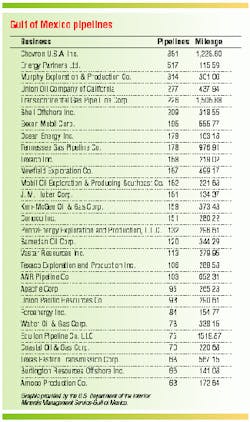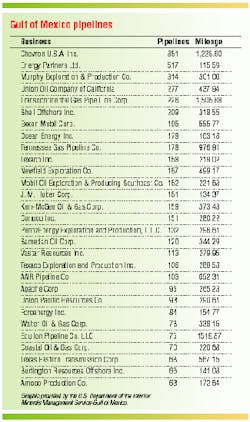GULF OF MEXICO: Deepwater pipelaying at standstill, but resurgence predicted shortly
Pipeline installation in US Gulf of Mexico federal deepwater areas has slowed down, partially a result of having reached the most accessible reserves, but also be-cause oil and gas producers are trying to find a cheaper alternative to very expensive deepwater lines.
More efficient solutions could include the selection of storage and offloading vessels at the production sites. These include FPSO tankers (floating production, storage, and offloading), tension leg platforms (TLP), or spars. The latter two are sensitive to storage, since they are ballasted down with tensioning members, but can easily produce to transport vessels if intermittent production can be considered.
Despite the current slowdown in numbers, however, the US Minerals Manage-ment Service (MMS) predicts a significant increase in deepwater pipeline installation in the coming years. The prediction is partly a result of analyzing the volume of pipeline installation made over the past six years. Interestingly, only three producers have installed pipelines or are proposing pipelines for water depths in federal waters in excess of 1,000 ft water depths.
A draft Environmental Impact Study (EIS) compiled in October 2000 by the MMS for the examination of FPSO deployment in the US Gulf of Mexico shows 58% of all existing deepwater pipeline mileage installed between 1990 and 1997 was installed during the 1996-1997 period (part of a pipeline mileage analysis compiled by the MMS appears in this article, and readers should note the list does not include state lines nor abandoned pipes that have been removed.)
Mileage projection
The MMS projects that 300-500 miles of pipeline will be installed in deepwater areas (>1,000 ft) annually between 2001 and 2010, not including replacement pipelines on the shelf to support deepwater operations. Pipelines extending to shore from a deepwater field will only be justified by a major discovery, according to the MMS. In addition to building new access lines on the continental shelf, operators have the option of increasing the maximum allowable operating pressure within an existing pipeline. However, retrofitting a pipeline and the accompanying equipment to accommodate higher pressures is not an inexpensive option.
The EIS draft states that in 1990-1995, growth in deepwater pipeline activities, from all pipelines installed in the Gulf of Mexico, fluctuated between 2% and 19% annually. By the 1996-1997 period, however, deepwater pipeline installations escalated dramatically, to a range of 34-36% of all pipelines installed in those years.
There are a number of engineering challenges in deepwater, some of which are common to on-the-shelf pipeline:
- Uneven sea-bottom surfaces
- High hydrostatic pressures
- Very cold temperatures
- Varying surface and subsurface current velocities and directions that affect surface equipment and access vehicles (ROVs)
- Installation activities cause bottom disturbances that result in turbidity that affects access vehicle visibility as well as ocean-bottom biological communities.
Deepwater installation
The Gulf of Mexico has a total of 7,664 pipelines. Total pipeline miles are 25,176.48. Of the 30 companies with the largest number of pipelines and longest mileage in the Gulf of Mexico deepwater, the MMS records Chevron as having the largest number. Chevron has a total of 861. Energy Partners, Ltd. is second with 517 pipelines. Murphy Exploration & Production Company is third with 314 pipelines.
The longest pipelines are owned by Equilon Pipeline Company, with 1,520 line mileage. Transcontinental Pipe Line Corporation has the second greatest, at 1,507 miles. Chevron is third with 1,229 miles.
Most of the top 30 operators on the MMS list have installed at least 100-300 miles of pipeline. The mileage of pipeline installed can be presented in estimated totals: three companies have extended their pipelines past 1,000 miles, estimated total; one company is listed as having 900 miles; one is at 600 miles; two are at 500 miles; two are at 400 miles; five are at 300 miles; nine are at 200 miles; and six are at 100 miles.
The number of pipelines owned by each company remains moderately at about 100. Analysis made when comparing pipeline ownership is similar to that made in comparing the length of pipelines. The number of pipelines owned jumps by about 200-300 miles between the top three companies.
In terms of the estimated numbers of pipelines owned by single companies, the table reveals the following: one company owns 800 pipelines, another owns 500 pipelines; another owns 300 pipelines; three companies own 200 pipelines; 14 own 100 pipelines; two own 90 pipelines; three own 70 pipelines; and three own 60 pipelines.

